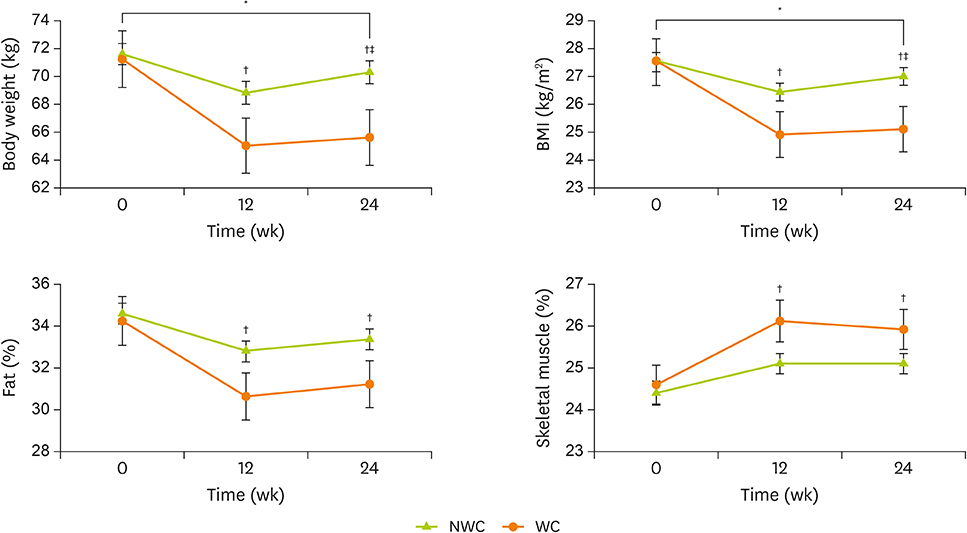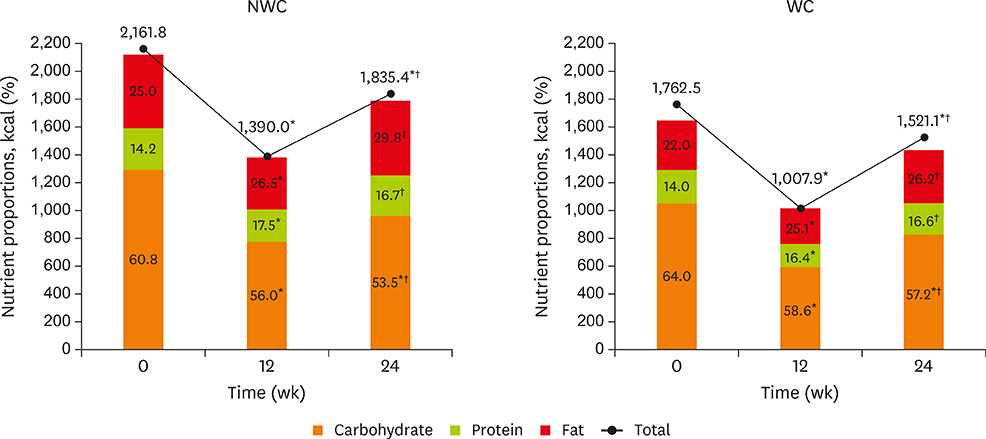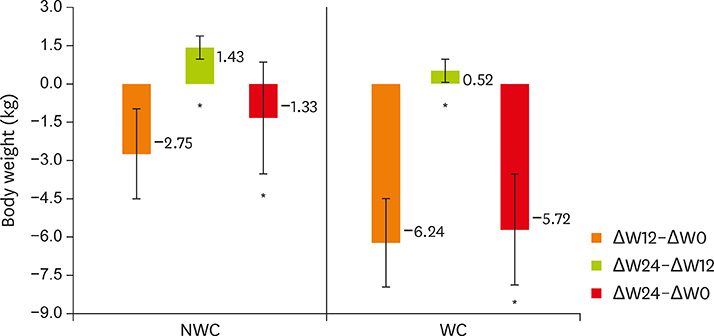Clin Nutr Res.
2017 Jul;6(3):183-197. 10.7762/cnr.2017.6.3.183.
Effect on 12-week Intensive Dietary and Exercise Program on Weight Reduction and Maintenance in Obese Women with Weight Cycling History
- Affiliations
-
- 1Department of Medical Nutrition, Graduate School of East-West Medical Science, Kyung Hee University, Yongin 17104, Korea. ypark@khu.ac.kr
- 2Department of Sports Medicine, Kyung Hee University, Yongin 17104, Korea. captain@khu.ac.kr
- KMID: 2385623
- DOI: http://doi.org/10.7762/cnr.2017.6.3.183
Abstract
- This study examined the effect of 12-week intensive dietary and exercise intervention program on body composition and stress-related hormones in obese women and to examine the residual effect after the intervention. The participants of this study were 30 obese women who had a body mass index of over 25 kg/m² and over 30% in body fat. They were classified into 2 groups depending on the history of weight cycling (WC); the WC group (≥±5% of the original body weight) and the non-weight cycling (NWC) group. Both groups were subject to a nutritional intervention program every 2 weeks with a mandatory exercise intervention for 12 weeks. Thereafter, the nutrition/exercise interventions were ceased for 12 weeks, after which the participants' levels of the hormones relating to energy metabolism and stress, meal intakes, dietary habits, level of knowledge on sodium intake, frequency of sodium intake, and quality of life (QOL) were checked. The changes of body weight were 71.3 ± 5.5 kg (week 0) vs. 65.0 ± 6.6 kg (week 12) vs. 65.6 ± 7.1 kg (week 24) in WC group and 71.6 ± 8.6 kg (week 0) vs. 68.8 ± 9.7 kg (week 12) vs. 70.3 ± 9.4 kg (week 24) in the NWC group. The levels of hormones, meal intakes, and QOL scores were better in the WC group, as adherence to the nutritional intervention was higher. We suggest that that adherence to dietary habits heavily influences weight loss and maintenance in individuals who frequently attempt to lose weight and consequently go through a vicious cycle of weight recycling.
Keyword
MeSH Terms
Figure
Reference
-
1. Chou SY, Grossman M, Saffer H. An economic analysis of adult obesity: results from the behavioral risk factor surveillance system. J Health Econ. 2004; 23:565–587.
Article2. World Health Organization. Obesity: preventing and managing the global epidemic. Report of a WHO consultation on obesity. Geneva: World Health Organization;2000.3. Kelly T, Yang W, Chen CS, Reynolds K, He J. Global burden of obesity in 2005 and projections to 2030. Int J Obes. 2008; 32:1431–1437.
Article4. Ministry of Health and Welfare, Korea Centers for Disease Control and Prevention. Korea Health Statistics 2015: Korea National Health and Nutrition Examination Survey (KNHANES VI-3). Sejong: Korea Centers for Disease Control and Prevention;2016.5. Kumanyika S, Jeffery RW, Morabia A, Ritenbaugh C, Antipatis VJ; Public Health Approaches to the Prevention of Obesity (PHAPO) Working Group of the International Obesity Task Force (IOTF). Obesity prevention: the case for action. Int J Obes Relat Metab Disord. 2002; 26:425–436.
Article6. Haslam DW, James WP. Obesity. Lancet. 2005; 366:1197–1209.
Article7. Catoira NP, Tapajóz F, Allegri RF, Lajfer J, Rodríguez Cámara MJ, Iturry ML, Castaño GO. Obesity, metabolic profile, and inhibition failure: young women under scrutiny. Physiol Behav. 2016; 157:87–93.
Article8. Kuczmarski RJ, Ogden CL, Grummer-Strawn LM, Flegal KM, Guo SS, Wei R, Mei Z, Curtin LR, Roche AF, Johnson CL. CDC growth charts: United States. Adv Data. 2000; 314:1–27.9. Catenacci VA, Wyatt HR. The role of physical activity in producing and maintaining weight loss. Nat Clin Pract Endocrinol Metab. 2007; 3:518–529.
Article10. Johnston BC, Kanters S, Bandayrel K, Wu P, Naji F, Siemieniuk RA, Ball GD, Busse JW, Thorlund K, Guyatt G, Jansen JP, Mills EJ. Comparison of weight loss among named diet programs in overweight and obese adults: a meta-analysis. JAMA. 2014; 312:923–933.
Article11. Oetoro S, Makmun LH, Lukito W, Wijaya A. Effect of a weight loss program on body composition and metabolic syndrome markers in obese weight cyclers. Acta Med Indones. 2014; 46:199–208.12. Lee RD, Nieman DC. Nutritional assessment. St. Louis (MO): Mosby;1996.13. Hamm P, Shekelle RB, Stamler J. Large fluctuations in body weight during young adulthood and twenty-five-year risk of coronary death in men. Am J Epidemiol. 1989; 129:312–318.
Article14. Saarni SE, Rissanen A, Sarna S, Koskenvuo M, Kaprio J. Weight cycling of athletes and subsequent weight gain in middleage. Int J Obes. 2006; 30:1639–1644.
Article15. Foster GD, Wyatt HR, Hill JO, Makris AP, Rosenbaum DL, Brill C, Stein RI, Mohammed BS, Miller B, Rader DJ, Zemel B, Wadden TA, Tenhave T, Newcomb CW, Klein S. Weight and metabolic outcomes after 2 years on a low-carbohydrate versus low-fat diet: a randomized trial. Ann Intern Med. 2010; 153:147–157.
Article16. Lee IM, Paffenbarger RS Jr. Change in body weight and longevity. JAMA. 1992; 268:2045–2049.
Article17. Klem ML, Wing RR, Lang W, McGuire MT, Hill JO. Does weight loss maintenance become easier over time? Obes Res. 2000; 8:438–444.
Article18. Park HR, Lee SN, Hong YH. Study of the practice of weight manegement attitude by middle-aged women. Korean J Aesthet Cosmet Soc. 2009; 7:107–122.19. Kim KA, Ahn GJ, Kim KW. Analysis of dietary habit, eating disorder and needs for nutrition education programs by weight control attempts among female college students. J Korean Soc Study Obes. 2004; 13:248–260.20. Korean Dietetic Association. Manual of medical nutrition therapy. Seoul: Korean Dietetic Association;2008.21. Shinkai S, Watanabe S, Kurokawa Y, Torii J, Asai H, Shephard RJ. Effects of 12 weeks of aerobic exercise plus dietary restriction on body composition, resting energy expenditure and aerobic fitness in mildly obese middle-aged women. Eur J Appl Physiol Occup Physiol. 1994; 68:258–265.
Article22. Lee KW, Yu YK, Lee WH. The study on the effect verification of aerobicㆍresistance exercise & diet control program for body shaping (weight & figure controlㆍphysical fitness promotion) in male & female college students. Korean J Sports Sci. 2014; 23:1115–1130.23. Goodyear LJ, Van Houten DR, Fronsoe MS, Rocchio ML, Dover EV, Durstine JL. Immediate and delayed effects of marathon running on lipids and lipoproteins in women. Med Sci Sports Exerc. 1990; 22:588–592.
Article24. Ahn SH, Kim YM, Ko SK. The effects of aerobic exercise and lifestyle modifying education program on body composition, lipoprotein and insulin resistance in the obese women. Korean J Sports Sci. 2011; 20:1097–1109.25. Blum WF, Englaro P, Hanitsch S, Juul A, Hertel NT, Müller J, Skakkebaek NE, Heiman ML, Birkett M, Attanasio AM, Kiess W, Rascher W. Plasma leptin levels in healthy children and adolescents: dependence on body mass index, body fat mass, gender, pubertal stage, and testosterone. J Clin Endocrinol Metab. 1997; 82:2904–2910.
Article26. Kim KD, Song YO, Baek YH. Effects of belly dancing and nutritional education on body composition and serum lipids profiles of obese women in a study, ‘obesity clinic projects at community healthcenter’. J Korean Soc Food Sci Nutr. 2011; 40:1417–1422.
Article27. Kim JH, Kwon YK, Cho HC. The effect of 12 weeks nutrition education and combined exercise on serum lipids and appetite hormone in the middle aged obese women. J Sport Leis Stud. 2013; 52:815–825.
Article28. Kim HA, Lee HS, Kim CS, Ahn CW, Chung YS, Lee KW, Huh KB, Kim DJ. Relationship with serum adiponectin concentrations and obesity in Korean children. J Korean Soc Endocrinol. 2003; 18:473–480.29. Tschritter O, Fritsche A, Thamer C, Haap M, Shirkavand F, Rahe S, Staiger H, Maerker E, Häring H, Stumvoll M. Plasma adiponectin concentrations predict insulin sensitivity of both glucose and lipid metabolism. Diabetes. 2003; 52:239–243.
Article30. Ministry of Health and Welfare (KR). The Korean Nutrition Society. Dietary reference intakes for Koreans 2015. Sejong: Ministry of Health and Welfare;2016.31. Fonseca-Alaniz MH, Brito LC, Borges-Silva CN, Takada J, Andreotti S, Lima FB. High dietary sodium intake increases white adipose tissue mass and plasma leptin in rats. Obesity (Silver Spring). 2007; 15:2200–2208.
Article32. Kim JH, Lim GE, Kang S, Lee K, Park TJ, Kim J. The relationship between daily sodium intake and obesity in Korean adults. Korean J Health Promot. 2015; 15:175–184.
Article33. Howarth NC, Saltzman E, Roberts SB. Dietary fiber and weight regulation. Nutr Rev. 2001; 59:129–139.
Article34. Greenway FL. Physiological adaptations to weight loss and factors favouring weight regain. Int J Obes. 2015; 39:1188–1196.
Article35. Hollis JF, Gullion CM, Stevens VJ, Brantley PJ, Appel LJ, Ard JD, Champagne CM, Dalcin A, Erlinger TP, Funk K, Laferriere D, Lin PH, Loria CM, Samuel-Hodge C, Vollmer WM, Svetkey LP; Weight Loss Maintenance Trial Research Group. Weight loss during the intensive intervention phase of the weight-loss maintenance trial. Am J Prev Med. 2008; 35:118–126.
Article36. Han KA, Patel Y, Lteif AA, Chisholm R, Mather KJ. Contributions of dysglycaemia, obesity, and insulin resistance to impaired endothelium-dependent vasodilation in humans. Diabetes Metab Res Rev. 2011; 27:354–361.
Article37. Jung SL, Lee SH, Huh MD. Effects of aerobic exercise and combined aerobic exercise with muscle strength exercise program on body fat distribution in obese women. J Sport Leis Stud. 2009; 35:881–888.
Article38. Kim DJ, Kwon CK, Choi DJ, Ka KH, Kim TM, Kim BT, Lee BK, Hwang JH, Ann ES, Kim DY. Effects of nutritional education and exercise intervention on improvement of diet intakes and metabolic risk factors in obese middle aged women. J Exerc Nutrition Biochem. 2009; 13:179–184.39. Choi CG. The effects of aerobic and resistance exercise on the changes of body fat percent and energy metabolism hormones in obese middle-school students. Korean J Sports Sci. 2010; 19:1207–1218.40. Jo JS, Han DN, Park HS. The depression in the obese. J Korean Acad Fam Med. 1995; 16:239–245.41. Mathias SD, Williamson CL, Colwell HH, Cisternas MG, Pasta DJ, Stolshek BS, Patrick DL. Assessing health-related quality-of-life and health state preference in persons with obesity: a validation study. Qual Life Res. 1997; 6:311–322.42. Chaung SK, Kim CG. Obesity-related quality of life in overweight and obese female college students. J Korean Acad Community Health Nurs. 2007; 18:543–551.43. Chun MY. The effect of obesity-related quality of life on selecting a goal for weight management in overweight and obese patients. Korean J Community Nutr. 2015; 20:281–290.
Article
- Full Text Links
- Actions
-
Cited
- CITED
-
- Close
- Share
- Similar articles
-
- Effect of Food Consumption Monitoring Using a Smartphone on Weight Changes in Obese Women
- Effect of Nutritional Education and Exercise Intervention on Reducing and Maintaining Weight in Obese Women
- Effects of Weight Control Program on Dietary Habits and Blood Composition in Obese Middle-Aged Women
- Effects of Weight Control Program on Nutrient Intakes and Physical Fitness in Obese Korean Adult Women
- The Effects of Circuit Hydraulic-Combined Training on Body Composition, Blood Pressure, and Blood Lipids in Obese Women





